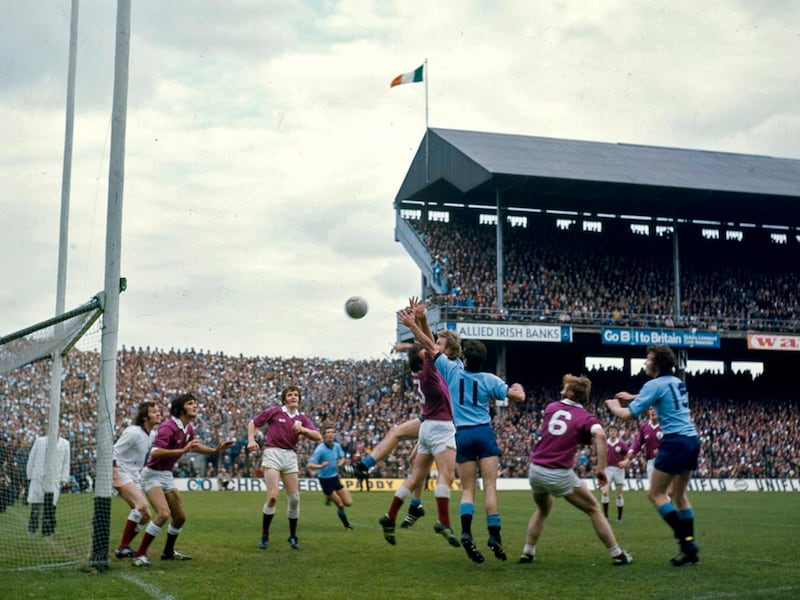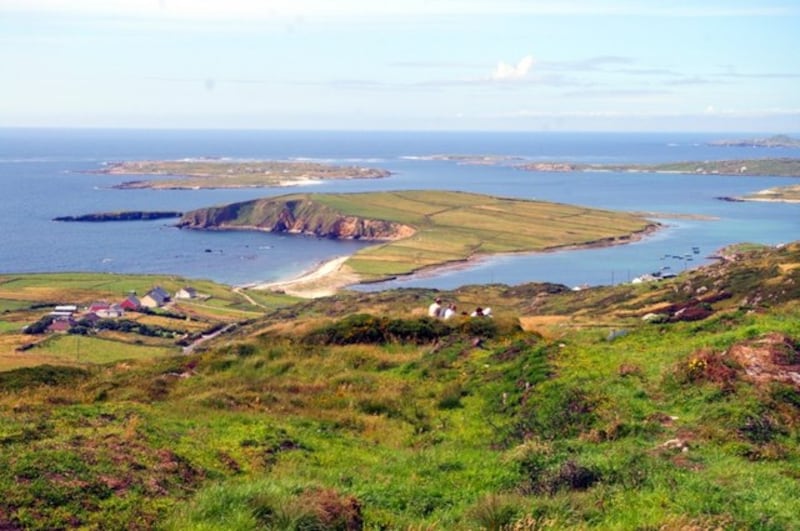This weekend, 50 years ago, it was all ahead of Jack Cosgrove. Galway’s full back, the first man from Clifden to play in an All-Ireland, was facing into a third final in four years.
That completed, he was hopeful that the following Saturday, Sam Maguire would be a guest of honour at his wedding to Margaret Darcy.
First though, the excitement of the match. Galway were under a lot of pressure, having lost two All-Irelands in the previous three years but their experience was seen by many as a major advantage over their opponents.
The Galway players, who had a week previously defeated Donegal in the All-Ireland semi-final, assumed, according to Cosgrove, they were heading for a rematch with champions Cork.
RM Block
[ Rebel rising 1973: Cork stake their claim to a place in modern footballOpens in new window ]
“In 1974, we were expecting to play them again. We were training in Tuam that Sunday and stopped in Galway in one of the selectors’ houses to watch the game. Suddenly we were looking at Dublin, instead of Cork, and a new plan – if there was one.”
On the Sunday, three men - Patrick Scuffle (48), Michael Wallace (62) and Patrick O’Toole (58) – were getting ready to make the short crossing from Inish Turbot (now more commonly known as Turbot or Turbot Island) to the mainland at Eyrephort.
Turbot had no electricity and for the three men, very interested in football and keen to see a local man lining out for the county in an All-Ireland, this was a match that had to be watched.
A lift had been ordered to take them the roughly 8km into Clifden and to return them to Eyrephort later that evening.
By the conclusion of the weekend, disaster would strike and not merely in terms of the sporting cliche – although that as well.
♦◊♦◊♦◊♦◊♦◊♦◊♦
There had been a previous brush with tragedy in the young life of Cosgrove. At 23 he was a Garda in Cork city and on Christmas Eve, 1972, part of a late patrol.
“We spotted a couple of fellas, who as soon as they saw us, ran off. It was beside Mayfield Church and they went around the back. The two guys with me went one side and I went the other through an open field. Being fit at the time, I caught the nearest guy.
“Next thing the other fella turned around and pulled a gun from under his coat and shouts: ‘You f***ing pig. Let him go or I’ll shoot.’ The man I was holding tried to get away and there was a bang. I got shot in the shoulder and it deflected into my lung. They were from a splinter republican group called Saor Éire and the two of them were on the run at the time from the Special Criminal Court.”
Saor Éire weren’t fussy about shooting gardaí and had murdered serving member Richard Fallon during a Dublin bank robbery, which shocked the country in 1970. This time, there would be no fatality but the crime left an enduring mark.
[ The sudden rise and rapid fall of Saor Éire Opens in new window ]
Although discharged that night he was back in hospital on Christmas Day for emergency surgery. The lung damage left him vulnerable to pneumonia and there followed five further weeks in hospital.
He was eventually compensated with £2,007 – “seven pounds for a hole in my sweater and two thousand for the hole in me”.
The effects easily outlasted the compensation.
“After surgery there was still a fragment in my shoulder which caused difficulties when I recently went for an MRI scan and they couldn’t do it in case the magnets would dislodge the bullet.”
♦◊♦◊♦◊♦◊♦◊♦◊♦
Cosgrove was the traditional full back personified but with added pace. He was selected in that position on the very first official All-Star football team in December 1971. The citation for his award read: “For the determination he brings to the game, his superbly confident fielding and his high degree of speed and adaptability.”
An ever-present on the Galway teams that lost three All-Ireland finals in four years in the 1970s – a tale of disappointment only exceeded by the county’s predecessors in the early 1940s, who lost three in succession – he can recall the optimism slipping away.
“We got to the first final in ‘71 and for a young fella from Clifden – the first to play in an All-Ireland final – it was a huge occasion and you feel you’re going to get back again. We did two years later but when you get there for a second time, you must win. The novelty is gone.”
Stationed in Cork, he was familiar with many of his opponents in 1973, as a player with St Nicholas, the football wing of the legendary Glen Rovers hurling club.
In fact, Cosgrove played an unwitting role in the advent of Cork’s teenage sensation, Jimmy Barry-Murphy, whose performance in a challenge match fast-tracked his call-up to the seniors.
“It was an All-Ireland Garda team played them in the Mardyke,” he groans in recollection. “A young skinny lad – you were hardly able to hit him! He was like an eel.”

In the 1973 final, JBM wasn’t asked to renew acquaintance with the Galway full back but in the corner, he still hit 2-1 from play.
Then a year later, the Dubs crashed the All-Ireland like an asteroid and Galway were left empty-handed yet again.
“Jack Cosgrove was outstanding in the early stages,” according to Paddy Downey in this newspaper.
But he was also subject to intense pressure from the opposition’s signature gambit – sending Tony Hanahoe out from centre forward to the wing, inviting the centre back to follow and create a highway down the middle of Galway’s defence.
“Tommy Joe Gilmore knew that he wasn’t going to mark a conventional centre forward. He said to the management, ‘what am I going to do?’ They said to follow his man.
“Tommy Joe didn’t kick a ball in that final and the whole centre was open in front of Keaveney. They could play it high, low, left, right – it didn’t matter because there was no block in the middle. I was a sitting duck!
“Instead of leaving Hanahoe out there for a while and letting Tommy Joe hold the centre and get forward, which might have changed the Dublin plan, we let it go.”
It remains a frustrating memory for him, a threshold between traditional ways and the dawning age of the manager, embodied by Kevin Heffernan.
“Galway had nearly as many selectors as players! Now, there was still just one voice that mattered – John ‘Tull’ Dunne, but we weren’t planning the way Heffo was. He had his homework done on us.”
[ How Dublin’s 1974 All-Ireland triumph changed football in the capital foreverOpens in new window ]
♦◊♦◊♦◊♦◊♦◊♦◊♦
There was a storm that night, September 22nd, 1974. According to Michael Finlan’s report on the front of The Irish Times, “A strong southwesterly gale was blowing and torrential rain was falling”.
Returning from the bar in Clifden – Cosgrove thinks it was Mannion’s – the three islanders were driven to where their currach was moored. Eyrephort is about 750m from Turbot.
It’s not far but there is a treacherous current. The men were experienced fishermen and boat handlers and would have made the crossing on countless occasions.
When they hadn’t returned that night, the assumption was that they had stayed on the mainland because of the weather.
In an interview with former Irish Times journalist Lorna Siggins, John O’Toole, a relation of Patrick and then resident on Turbot, outlined how word spread.

“The currach was found next day,” he said. “But it was several days before their families knew for certain, as there were no phones, and because sometimes the islanders stayed overnight in Eyrephort if the weather was too bad to make the crossing.
“Only four men know what happened: the three who were lost and the man above.”
Cosgrove knew the islands well. “I would be from about four miles west of Cleggan – Aughrismore – not far from Omey Island. It’s near Claddaghduff. You could see Inishturk and Inish Turbot from my front door.”
By Monday, word was arriving in Dublin by telephone, dreaded fragments of the disaster being pieced together among Galway people, including Cosgrove.
“Whereas I wouldn’t have been close to those three gentlemen personally – they were at least 20 years older than me – I’d have known them to see because they would come talking about football.
“They would have kicked a ball around on a Sunday because there was no team at that time from the islands – the inter-islands competition only came about in later years. When a match came on television, they were straight over to Clifden to see it.
“I met some of the relatives there on the Tuesday on the shoreline. It was sad and I was saying to myself, ‘if we had only won it, they mightn’t have come home until the next day – you know, with the celebrations taking over’. There are all these what-ifs.”
Amid the turmoil, there was the wedding in Clifden. On Saturday, September 28th, Jack and Margaret were married. Next weekend they celebrate their golden anniversary.
Tommy Joe Gilmore, untethered from Hanahoe, was the best man and there was happiness and celebration even amid the dark undercurrent of events.
“The bodies weren’t actually found for two weeks,” remembers Cosgrove. “That was probably worse because the anticipation was still there. The search for bodies was still going on and, in the area where it happened, there’s a huge current sweeping between the islands and out to sea.
“They found them two weeks later. It put a lot of things into perspective. In one way it takes a lot out of your mind. With the preparations for the wedding, there was a whole lot going on. The wedding went ahead and she’s still here!”
♦◊♦◊♦◊♦◊♦◊♦◊♦
Fifty years later there are reminiscences and consequences. Although the general area was also the scene of a maritime disaster in 1927 when 45 fishermen from the islands were drowned when a lethal storm blew up without warning, the three men are the only fatalities from Turbot.
From a 19th-century high of nearly 200, the population had fallen to around 60 in the early 1970s. Without electricity, phones or, by the end, turf, which had been exhausted by selling it on the mainland for extra income, life on Turbot was hard and older inhabitants already wanted to move to ensure a better life for the young.
The drownings tipped the balance. Land commission houses were built across the water and in 1978 there was a general evacuation. There has though been renewal since. The houses have proved popular as holiday homes or even for longer stays.
In 2020, a video was launched of the poem, Turbot Men, written about the deaths by mainland resident Joseph O’Toole and set to music by Peter Knox. Twenty-one years ago, the island was electrified and is served by satellite internet.
Dublin and Galway footballers retained their own connections. In Croke Park last April they came together. Funds had been raised for the Raheny Hospice, where two of Dublin’s team, Anton O’Toole and Brian Mullins, had been cared for during their terminal illnesses.
Galway 1974 captain and goalkeeper Gay Mitchell spoke that day from the heart. His daughter Aoife had died a decade ago in her 30s in the Galway Hospice.
“Then they came to Galway in July,” says Cosgrove, “the day of the All-Ireland quarter-final, and played golf in Galway Golf Club. They were staying in Salthill and we sat down to watch the match afterwards. It was a very sweet dinner!
“They’re a fine bunch, though. The Dublin lads hadn’t been aware of his daughter’s passing until Gay spoke about it in Croke Park in April. So, in July Seán Doherty [Dublin captain and full back] gave him a cheque for €5,000 for the hospice in Galway. It was a lovely gesture.”
In life and death, solidarity.
On Sunday it will be exactly 50 years since three men set off on a familiar journey and in the night, sporting disappointment turned into something unimaginably darker.
- Sign up for push alerts and have the best news, analysis and comment delivered directly to your phone
- Find The Irish Times on WhatsApp and stay up to date
- Our In The News podcast is now published daily – Find the latest episode here





















